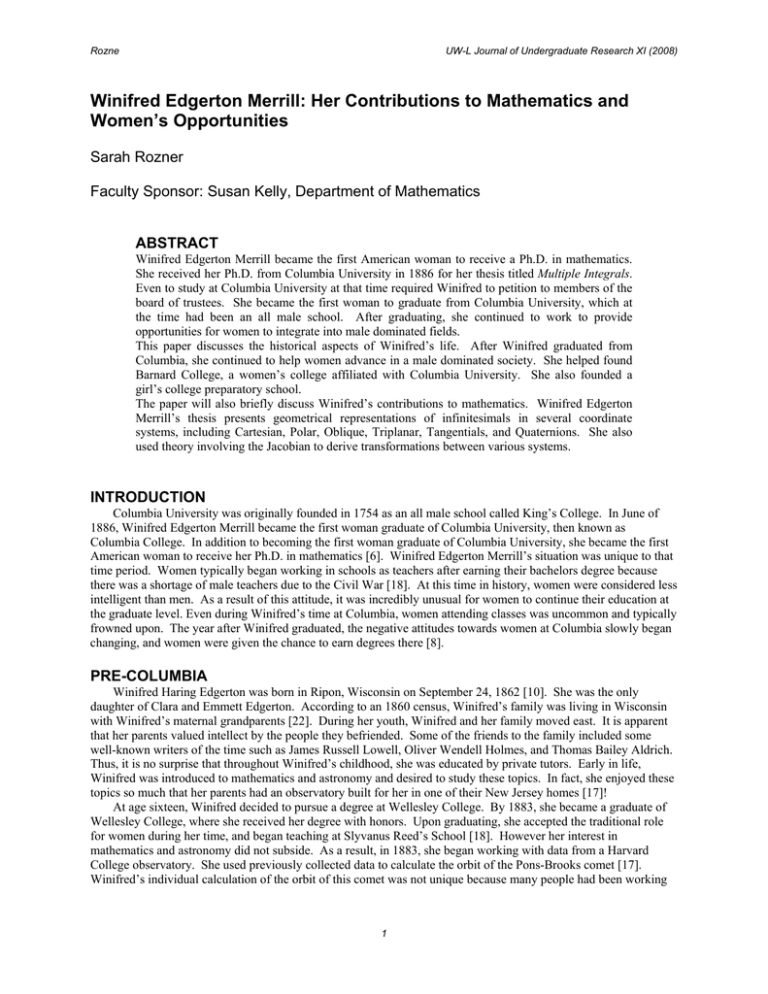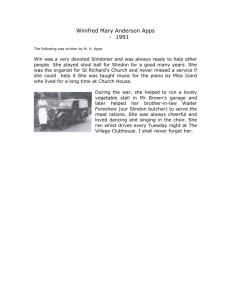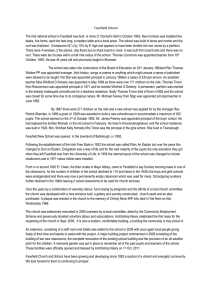Winifred Edgerton Merrill: Her Contributions to Mathematics and Women’s Opportunities Sarah Rozner
advertisement

Rozne UW-L Journal of Undergraduate Research XI (2008) Winifred Edgerton Merrill: Her Contributions to Mathematics and Women’s Opportunities Sarah Rozner Faculty Sponsor: Susan Kelly, Department of Mathematics ABSTRACT Winifred Edgerton Merrill became the first American woman to receive a Ph.D. in mathematics. She received her Ph.D. from Columbia University in 1886 for her thesis titled Multiple Integrals. Even to study at Columbia University at that time required Winifred to petition to members of the board of trustees. She became the first woman to graduate from Columbia University, which at the time had been an all male school. After graduating, she continued to work to provide opportunities for women to integrate into male dominated fields. This paper discusses the historical aspects of Winifred’s life. After Winifred graduated from Columbia, she continued to help women advance in a male dominated society. She helped found Barnard College, a women’s college affiliated with Columbia University. She also founded a girl’s college preparatory school. The paper will also briefly discuss Winifred’s contributions to mathematics. Winifred Edgerton Merrill’s thesis presents geometrical representations of infinitesimals in several coordinate systems, including Cartesian, Polar, Oblique, Triplanar, Tangentials, and Quaternions. She also used theory involving the Jacobian to derive transformations between various systems. INTRODUCTION Columbia University was originally founded in 1754 as an all male school called King’s College. In June of 1886, Winifred Edgerton Merrill became the first woman graduate of Columbia University, then known as Columbia College. In addition to becoming the first woman graduate of Columbia University, she became the first American woman to receive her Ph.D. in mathematics [6]. Winifred Edgerton Merrill’s situation was unique to that time period. Women typically began working in schools as teachers after earning their bachelors degree because there was a shortage of male teachers due to the Civil War [18]. At this time in history, women were considered less intelligent than men. As a result of this attitude, it was incredibly unusual for women to continue their education at the graduate level. Even during Winifred’s time at Columbia, women attending classes was uncommon and typically frowned upon. The year after Winifred graduated, the negative attitudes towards women at Columbia slowly began changing, and women were given the chance to earn degrees there [8]. PRE-COLUMBIA Winifred Haring Edgerton was born in Ripon, Wisconsin on September 24, 1862 [10]. She was the only daughter of Clara and Emmett Edgerton. According to an 1860 census, Winifred’s family was living in Wisconsin with Winifred’s maternal grandparents [22]. During her youth, Winifred and her family moved east. It is apparent that her parents valued intellect by the people they befriended. Some of the friends to the family included some well-known writers of the time such as James Russell Lowell, Oliver Wendell Holmes, and Thomas Bailey Aldrich. Thus, it is no surprise that throughout Winifred’s childhood, she was educated by private tutors. Early in life, Winifred was introduced to mathematics and astronomy and desired to study these topics. In fact, she enjoyed these topics so much that her parents had an observatory built for her in one of their New Jersey homes [17]! At age sixteen, Winifred decided to pursue a degree at Wellesley College. By 1883, she became a graduate of Wellesley College, where she received her degree with honors. Upon graduating, she accepted the traditional role for women during her time, and began teaching at Slyvanus Reed’s School [18]. However her interest in mathematics and astronomy did not subside. As a result, in 1883, she began working with data from a Harvard College observatory. She used previously collected data to calculate the orbit of the Pons-Brooks comet [17]. Winifred’s individual calculation of the orbit of this comet was not unique because many people had been working 1 Rozne UW-L Journal of Undergraduate Research XI (2008) on the orbit calculation. However this was only the second time the comet had appeared. These calculations show that the Pons-Brooks comet has an orbit of nearly seventy years [19]. Winifred’s work with the data from Harvard became a stepping stone that helped her gain access to the telescope at Columbia University [8]. Although Winifred continued teaching, her desire to continue her work in astronomy and mathematics remained. From her acquaintance with Columbia’s librarian, Mr. Dewey, Winifred was introduced to the President of Columbia University, President Barnard [3]. President Barnard was an advocate of women interested in pursing higher education. Having made the acquaintance of President Barnard, Winifred petitioned to Columbia University for use of the school’s telescope on January 5, 1884 [8]. Initially her petition was rejected, but she was encouraged to meet with members of the Board of Trustees to gain use of the telescope. Reverend Morgan Dix, dean of students and a member of the board, was strongly opposed to women in higher education. However, Winifred was able to win him over, and he eventually became a friend and advocate to her [17]. On February 4, 1884 the members of the board of trustees gave Winifred permission to use the school’s telescope. The members of the board considered her to be an “exceptional case.” The board of trustees decided since Winifred wasn’t specifically seeking admission to Columbia, and that there wasn’t another facility in New York City where she could access a telescope, they would allow her to use Columbia’s. Additionally, they looked at the work she had done at Harvard and deemed her to be proficient in the subject matter. She was also told that she was “not to disturb the male students,” and that she must serve as a laboratory assistant to the director of the observatory [5]. COLUMBIA It was a great accomplishment that Winifred received permission to use the telescope at Columbia, however gaining access was not the only challenge she would face. When she gained permission to use the telescope in February of 1884, she was assigned to study Astronomy (and mathematics) under Professor John Rees [5]. Winifred was not the first woman to attend classes at Columbia, but at this time it was frowned upon for women to attend lectures. As a result, most women studied their subject of interest from the course text. In one of the mathematics courses Winifred took, some men in the class asked the professor to choose one of the hardest textbooks of the time with hopes that Winifred would fail since she would not be able to attend lecture [18]. This attempt backfired because Winifred had already studied that text at Wellesley. This did not discourage her from studying mathematics; her two favorite professors, Professor Van Amringe and Professor Peck, were professors in mathematics [7]. Another challenge Winifred faced during her time at Columbia was the amount of time she spent in solitude. Since she was not supposed to interact much with the male students, she was forced to spend many hours alone. However, like the other challenges she had faced, she found a way to overcome the loneliness. Winifred kept a chest of twenty dolls up in the laboratory that she played with when she was alone. Since her work required use of the telescope and she was a laboratory assistant to the astronomy director, she spent many hours up in the laboratory cleaning and caring for instruments and studying. Her parents remained supportive of her work and the late hours she put in [7]. As a friend and supporter of Winifred, Reverend Morgan Dix asked a committee on March 1, 1886 to nominate Winifred for her degree [17]. Members of this committee were impressed with Winifred’s work, and they granted her the opportunity to receive her degree. Winifred Edgerton Merrill was not the first American woman to earn her Ph.D. in Mathematics. That honor goes to Christine Ladd Franklin who earned her Ph.D. in mathematics just four years previously in 1882 from John Hopkins University. However, Christine Ladd Franklin was not awarded her Ph.D. at this time because she was a woman [11]. On June 7, 1886, just two and a half years after Winifred entered Columbia, she had gathered enough information to complete her thesis on Multiple Integrals. She became the first woman graduate of Columbia, and the first American woman to receive her Ph.D. in mathematics. In addition to those honors, she was awarded her Ph.D. cum laude [6]. As Winifred walked across the stage to receive her diploma, she received more than two minutes of applause from the men in the audience [3]. Her son’s journal mentions that during the graduation ceremony she was bombarded with flowers and required the assistance of a professor to help her carry the flowers off the stage [17]. These instances show that not all men were opposed to Winifred studying at Columbia. THESIS Winifred Edgerton Merrill’s 1886 doctoral thesis was titled Multiple Integrals [9]. In her handwritten thesis, several ideas were presented. These topics included unifying the systems of Analytical Geometry, extending Trilinear and Tangential systems from two-dimensions to three-dimensions, and developing a way to change 2 Rozne UW-L Journal of Undergraduate Research XI (2008) coordinate systems for multiple integrals. The systems of Analytical Geometry that she considered were Cartesian, Oblique, Polar, Trilinear/Triplanar, Tangential, and Quaternions. The focus of our research involved the Cartesian, Oblique, Polar, and Trilinear/Triplanar systems. Winifred’s thesis examined both geometric and analytic approaches to find the infinitesimals of the systems listed above. Infinitesimals are small units of length, area, and volume that are used in calculating integrals. The geometric approach used pictures to identify the infinitesimals for length, area and volume. We will define the Oblique, Trilinear, and Triplanar coordinate systems and discuss the various geometrical interpretations of the infinitesimals. The Oblique coordinate system in a two-dimensional system is similar to Cartesian Coordinates. It differs from the Cartesian because the angle between the X-axis and Y-axis is not ninety degrees, thus the X-axis is not perpendicular to the Y-axis. Like the Cartesian system, any point can be found within the four quadrants and is represented by the corresponding ordered pair which determines its location from the origin. To find the area infinitesimal, two parallel lines are drawn from both the axes. Geometrically, the infinitesimal in the oblique yields a parallelogram. Thus the area term is represented by sin(θ)dXdY, where θ is the angle between the two axes (see Figure 1.1). The three-dimensional case is similar. θ Figure 1.1 The Trilinear coordinate system is a two-dimensional system not commonly used today, that uses a reference triangle. Any point P within that triangle is represented by a triplet (α, β, γ) as seen in Figure 1.2. The triplet values are the lengths of the lines perpendicular to the sides of the triangle. Winifred extended the Trilinear coordinates to a third dimension called Triplanar. In the Triplanar system, we can find any point in a trihedral by extending lines perpendicular to three of the planes of a trihedral. Figure 1.2 In order to study the infinitesimals of the Trilinear and Triplanar systems, it can be shown that the infinitesimal for the Trilinear or Triplanar systems is much like those of the oblique coordinate system. For Trilinears, this can be shown by extending two parallel lines from two different edges of the triangle outward to form a parallelogram. As a result, the geometric view of the infinitesimal for the Trilinear coordinate system is much like those of the Oblique coordinate system, where θ is the angle between the intersecting lines. After we understood the geometric interpretations of the infinitesimals, the next step was to study the analytic approach to change between coordinate systems. The notation Winifred used was different than notation mathematicians commonly use today. Kaplan’s Advanced Calculus uses more modern notation and methods to help 3 Rozne UW-L Journal of Undergraduate Research XI (2008) guide us through the ideas found for the analytical interpretations. The idea behind the analytical approach used determinants to transform the infinitesimals of one system to another system [9]. Changing between coordinate systems in two-dimensions required an application of Green’s Theorem: “Let C be a positively oriented, piecewise-smooth, simple closed curve in the plane and let D be a region bounded by C. If P and Q have continuous partial derivatives on an open region that contains D, then the line integral over C of (Pdx + Qdy) is equal to the double integral over D of (Qx –Py ) dA [11].” At the time of her thesis, Green’s theorem was relatively new, having only been published for forty years when Winifred wrote her thesis [12]. The proof to change between coordinate systems in two-dimensions applies Green’s Theorem twice. Let us begin with a double integral in the xy-plane. Applying Green’s Theorem allows us to change from a double integral in the xy-plane to a line integral in terms of x and y. Then by applying a change of variables, we change the line integral in terms of x and y to a line integral in terms of u and v. Applying Green’s Theorem a second time takes the line integral in terms of u and v and changes it to a double integral in the uv-plane (see Figure 1.3). Thus changing a double integral in the xy-plane to an integral in the uv-plane, the infinitesimals dxdy change to |J| dudv, where the Jacobian, denoted by |J|, is a matrix of partial derivatives (see Figure 1.4). Thus for the case above, dxdy is replaced by |J| dudv. Figure 1.3 Figure 1.4 The work in Winifred’s thesis was extended to higher dimensions, and is not limited to our focus of one, two, and three dimensions. Additionally, her work allowed for implicit and explicit formulas to be used to change from one coordinate system to another [9]. To conclude our work with the thesis, we considered how we could change a double integral from the Cartesian coordinates to a double integral in the Polar coordinates. The explicit formulas are defined such that x= r cos(θ) and y= r sin(θ). The Jacobian for this example can be seen in Figure 1.5. xr |J| xθ = = yr yθ cos(θ) - r sin(θ) sin(θ) r cos(θ) = r cos2(θ) + r sin2(θ) = r Figure 1.5 Thus, using the analytical approach, we see the infinitesimals dxdy would change to rdrdθ when changing from Cartesian coordinates to Polar coordinates. POST COLUMBIA After graduation, Winifred continued teaching at Slyvanus Reed’s School where she became the Vice Principal [18]. As a result of Winifred’s academic achievements, Columbia University gave women the opportunity to earn degrees in 1887 if the necessary tests were passed [8]. Winifred, despite having assumed the non-traditional role as a graduate student, would soon assume a more traditional role. In September of 1887, she married Frederick Merrill, 4 Rozne UW-L Journal of Undergraduate Research XI (2008) a geology student at Columbia. Choosing to marry required giving up an offer for a professorship position at Smith’s College [17]. Having proven herself at Columbia, Winifred was invited to serve on a committee to found Barnard College, an affiliate of Columbia specifically for women. In 1888, she became one of five members to serve on the committee [17]. Since this committee often met in downtown offices with men, her husband became uncomfortable with these arrangements and Winifred was forced to quit [7]. Winifred and Frederick had four children together. On June 3, 1888, Winifred gave birth to her first child, Louise Merrill [17]. Before they had their second child, Frederick completed his Ph.D. at Columbia in 1890 which he earned with honors [2]. Their first son, Hamilton Merrill, was born on December 21, 1890. Nearly seven years later, they had their second daughter, Winifred Merrill, born July 21, 1897. Their last child, Edgerton Merrill, was born April 21, 1901. Winifred and Frederick had received family money from Frederick’s family. Frederick’s mother, Louisa Merrill, and his uncle, Nelson Merrill, each gave $100,000 to Winifred and Frederick. This is a substantial amount of money during that time. To put this into perspective, as the state geologist Frederick annually earned $3,500 and the average annual salary was less than $700! In Hamilton Merrill’s journal, he writes that it was evident his family had money because each time the family moved, they moved to a more prestigious residence with more hired help. Hamilton mentions that one of their homes even had a bowling alley [17]! Like Winifred’s parents, Winifred and Frederick valued intellect and the prominent position they held in Albany society. They often entertained Teddy Roosevelt and his family. The Roosevelt children attended school with the Merrill children, so these families were well acquainted [17]. In addition, Winifred was known to entertain educator Booker T. Washington, founder of Tuskegee Institute. Tuskegee Institute was a school founded in 1881 specifically for African American teachers [20]. We can only guess that Winifred and Booker had much to talk about in terms of struggling to get an education and the obstacles they had to overcome to accomplish what they did. In 1902, only one year after the birth of Winifred and Frederick’s fourth child, the family began having financial difficulties. Hamilton Merrill blames his mother for throwing “lavish parties, spending frivolously, and making bad investments,” nonetheless some of this money was spent on her family. However, these lavish parties may have served as an outlet for Winifred since she had given up her work with math and astronomy and was not allowed to pursue her academic interests. These financial difficulties would eventually lead to disagreements with Frederick, and in 1904, Winifred and Frederick separated [17]. After the separation in 1904, both Frederick and Winifred were able to actively pursue their professional careers again. Frederick moved west to work, while Winifred became the principal at Anne Brown’s School for Girls. During this time, Winifred attempted to furnish and rent apartments [17]. In 1906, Winifred founded Oaksmere School for Girls in New Rochelle, New York, which is also known as Mrs. Merrill’s School [15]. In 1908, the school was relocated to Mamaroneck, New York [17]. Oaksmere was a college preparatory school for girls which offered a variety of courses. Despite its scholarly achievements, Oaksmere only attracted girls from prominent families because it cost $2,400 annually to attend [16]. Due to Oaksmere’s success in New York, a Paris branch was opened in 1921. In addition to preparing young girls for college, Oaksmere provided them with the opportunity to become involved in athletics. The Mamaroneck campus had a variety of athletic facilities available, including a large outdoor track and an indoor swimming pool [16]. As a result of women not being allowed to participate in the 1920 Olympics, some Oaksmere girls participated in the first international track meet for women. This meet was hosted in 1922 in Paris [1]. The girls that attended Oaksmere had the opportunity to participate in track meets from 1921 through 1924 [14]. In May of 1923, an Oaksmere girl actually set a record for the shot-put [13]. The school thrived for some time before financial difficulties were encountered. Prior to financial difficulties, Winifred and Oaksmere funded a Paris ambulance for World War I [10]. Yet Winifred would become responsible for spending lavishly yet again. One example of this extensive spending was during the construction of the school pool. Nearly $10,000 was raised to erect a pool, but roughly $30,000 was spent to build this pool. As a result of these financial difficulties, the Oaksmere was forced to close in 1928. However, just three years previously in 1925, Winifred attempted to open another school in Larchmont, however this attempt failed. In 1926, Winifred finally retired from her academic career [17]. In 1933, Columbia honored Winifred by hanging her portrait within Philosophy Hall, an academic building at Columbia. She is often referred to as the woman who “opened the doors” [4]. Others, including her son, Hamilton Merrill, are known for saying that Winifred “startled the academic world” [17]. Her perseverance to access Columbia’s telescope allowed her to continue her work, and as a result she was rewarded her degree. Since Winifred was an “exceptional case” at the time of her petition, many had stated that her using Columbia’s facilities were to by no means set precedence [5]. She paved the path that other women would soon be given the opportunity to follow. 5 Rozne UW-L Journal of Undergraduate Research XI (2008) In addition to founding schools, Winifred continued her scholarly work and published some articles. In addition, she published a book with her son-in-law Robert Russell Bennett, titled “Musical Autographs” and was the editor of two other books titled “Renaissance Vistas” and “Historical Vistas” [21]. She also continued to serve on committees, and at one time was the editor of the Mathematical Association of America newsletter [17]. During the last years of her life, from 1948 through 1951, Winifred worked as a librarian at the Barbizon Hotel in New York City. On September 6, 1951, at age 88, Winifred Edgerton Merrill passed away in Connecticut after a lingering illness [17]. CONCLUSION Winifred Edgerton Merrill pioneered the way for women to continue education. Instead of losing hope when Columbia initially denied her access to the school’s telescope, she silently petitioned again. She became the first American woman to receive her Ph.D. in mathematics, and helped give other women the chance to earn and receive degrees as well. Uncommon as it was for women to continue in education, Winifred followed tradition and married after graduating from Columbia. She, like many other women of that time, raised a family. However, when her marriage broke apart, she was able to pursue her love for mathematics, astronomy, and learning. As a result, she opened college prep schools for girls. These schools gave young women background in a variety of areas, but they also encouraged these young women to pursue athletics. Winifred helped women emerge and become more active in the male dominated society that she lived in. ACKNOWLEDGEMENTS I would like to thank my research mentor, Dr. Susan Kelly, for her guidance throughout this project. I would also like to thank the faculty and staff within the UW-L Department of Mathematics for their support throughout this project. Additionally, I would like to thank the UW-L Undergraduate Research Grants Program for funding this project. REFERENCES Columbia College (South Carolina). Edens Library. Jane Tuttle and her research on The First International Track Meet for Women. http://www.colacoll.edu/edenslibrary/jane/team.htm Columbia University Archives. Alumni Federation Index Card. Columbia University Archives. “Columbia’s First Woman Graduate.” Columbia Today. Volume 3, No. 3. Joan S. Faier. Winter 1977. Columbia University Archives. “Columbia Honors its First Woman Graduate.” New York Times. April 1, 1933. Columbia University Archives. Excerpt from Trustee Minutes. February 4, 1884. Columbia University Archives. Excerpt from Trustee Minutes. June 7, 1886. Columbia University Archives. Interview with Winifred Edgerton Merrill. October 4, 1944. Columbia University Archives. Morgan Dix Diary. “Typed Journal of Morgan Dix.” Columbia University Archives. Winifred Edgerton Merrill’s Thesis “Multiple Integrals” 1886. Harvard University. The Radcliffe Institute for Advanced Study. Schlesinger Library. Mary Elizabeth Williams Collection. John Hopkins University: The Sheridan Libraries. “Women at the John Hopkins University: A History.” Chapter 2: Exceptions to the Rule, 1877-1909. Katz, Victor J. “The History of Stoke’s Theorem.” Mathematical Magazine, Vol. 52, No. 3. Mathematical Association of America. May 1979. Mamaroneck Historical Society. “An Oaksmere Girl Breaks Record.” Mamaroneck Paragraph. May 24, 1923. Mamaroneck Historical Society. Letter to Historian Gloria Pritts from Louise Tricard. July 6, 1993. Mamaroneck Historical Society. Letter to Louise Tricard from Historian Gloria Pritts. June 23, 1993. Mamaroneck Historical Society. Oaksmere: Mrs. Merrill’s Boarding and Day School for Girls. 1921. Merrill, Hamilton. “Frederick James Hamilton Merrill and Winifred Edgerton Merrill.” September 4, 1974. Minderovic, Z., Young, R. Notable Mathematicians: from ancient times to the present. “Winifred Edgerton Merrill.” pp344-345. Detroit: Gale. 1998. Sawyer, Helen. “Out of Old Books.” Journal of the Royal Astronomical Society of Canada, Vol. 48, p.74. Tuskegee Institute. “History of Tuskegee Institute.” 2003. http://www.tuskegee.edu/Global/story.asp?S=1070392&nav=menu200_2. 6 Rozne UW-L Journal of Undergraduate Research XI (2008) White, J.T. The National Cyclopaedia of American Biography. Vol. 41. “Winifred Edgerton Merrill.” pp113. New York. 1893. 1860 Federal Census Fond du Lac County, Wisconsin for the Town of Ripon. Transcribed by Adolph W. Johnson, Jr. 2002. 7






